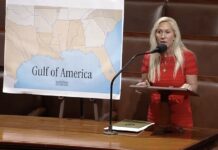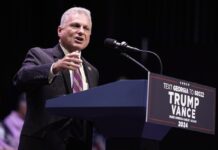
(GA Recorder) — The U.S. Department of Agriculture will begin to administer two loan and grant programs worth nearly $11 billion to boost clean energy systems in rural areas, administration officials said Tuesday.
Congress approved the federal spending — $9.7 billion for a grant and loan program the department is calling the New Empowering Rural America program, or New ERA, and $1 billion for a Powering Affordable Clean Energy program that will provide partly forgivable loans — in the energy, health and taxes law Democrats passed last summer.
The funding “continues an ongoing effort to ensure that rural America is a full participant in this clean energy economy,” Agriculture Secretary Tom Vilsack told reporters on a teleconference in advance of the announcement.
Rural areas can have more difficulty than more urban ones in attracting private sector investment, White House National Climate Advisor Ali Zaidi said. The programs are intended to allow those rural areas to take advantage of an industry-wide trend to invest in clean energy production.
“There’s a favorable wind blowing here,” he said. “This allows rural communities to put up a sail.”
The programs are meant to put rural electric cooperatives on equal footing with larger privately owned companies that have already put major funding into clean energy deployment, Vilsack said.
The programs represent the largest single funding effort for rural electrification since President Franklin Roosevelt signed the Rural Electrification Act in 1936, a USDA press release said.
The money is meant not only to address the climate impacts of fossil fuel energy and reduce home energy costs but to act as an economic engine for rural areas, Zaidi said.
Zaidi cited a Stateline analysis that showed seven of the top 10 largest gross domestic product growth increases between 2019 and 2021 had significant wind farm production.
“This is a proven driver of economic growth on the ground,” Zaidi said. “We want more folks to be able to tap into that opportunity. We’re seeing this not only translates into lower energy costs, but, to places that had been shut down, turning back on as sources of economic opportunity.”
Rural electric cooperatives are eligible for the New ERA program. Up to 25% of the funding in that program can be in the form of direct grants. Utilities can use the money to build renewable energy systems, zero-emission systems, and carbon capture facilities, according to the department release.
The climate law allows “the stacking of benefits,” Vilsack said. That means utilities that receive loans and grants through the program can also use the clean energy tax credits that were approved in the law, he said.
The USDA will begin to accept initial applications for funding on July 31. Applicants are expected to write more detailed proposals for funding after the USDA accepts their initial applications.
The PACE program provides loans to renewable energy developers and electric service providers “to help finance large-scale solar, wind, geothermal, biomass, hydropower projects, and energy storage in support of renewable energy systems,” the release said.
The program is targeted to “vulnerable, disadvantaged, Tribal and energy communities,” the release said. It’s in line with a Biden administration goal to give at least 40% of the overall benefits of certain federal spending to disadvantaged communities.
The USDA can forgive up to 40% of most of the loans in the program. Up to 60% of loans to applicants in some U.S. territories and tribal communities can be forgiven.
Initial applications for that program will open on June 30.







